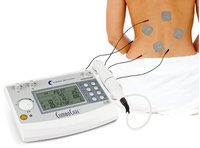 12th Oct 2015
12th Oct 2015
Electrical Stimulation and the Treatment of Phantom Pain
Phantom pain is pain that feels like it's coming from a body part that's no longer there. Doctors once believed this

post-amputation phenomenon was a psychological problem, but experts now recognize that these real sensations originate in the spinal cord and brain. For some people, phantom pain gets better over time without treatment, but most people need treatment, including physical therapy, in order to treat phantom pain effectively.
According to a newly published study in the most recent edition of The Journal of Rehabilitation Research and Development, electrical stimulation on the skin surface at the elbow can produce feeling in the hand — including rare natural sensations. Researchers hope this surface electrical stimulation might someday be able to be used to provide natural sensations in body areas distant from where the stimulation occurs. If that becomes possible, the development could then lead to improved treatment for phantom limb pain, according to Katharine H. Polasek, PhD, assistant professor of engineering at Hope College in Holland, Mich.
According to a 2011 report from the Limb Loss Research & Statistics Program, 80% of amputees reported phantom limb pain. This means that though the limb is gone, people can experience pain, tingling, cramping and feelings of heat and cold — virtually any sensation an existing limb could have. This pain causes psychological discomfort as well as physical, making the treatment of phantom pain a necessity. This is especially timely as currently statistics show 500 Americans lose a limb each day.
What is Electrical Stimulation?
Electrical stimulation (E-stim) uses the strategic placement of electrodes to apply electrical current to specific muscles. E-stim can be used for neuro-muscular re-education, decreasing pain and edema, decreasing atrophy and muscle spasms while increasing range of motion.
The ComboCare by Roscoe Medical is the most popular E Stim and Ultrasound
machine used by our Clinics to treat phantom pain.
In the study referenced above, Surface electrical stimulation to evoke referred sensation, Polasek and a team of undergraduate researchers at Hope College conducted 46 testing sessions with 35 people to learn whether electrical stimulation at their elbows could produce “referred sensation” in their hands without causing discomfort anywhere else. They also wanted to see if it was possible to produce a natural sensation, not simply a tingling or prickling perception.
Using controlled conditions, the electrodes were attached to subjects at either the sites of the ulnar or median nerves at the elbow position during the sessions. In each session, researchers found the participants felt sensation in their hands.
The feeling itself varied from participant to participant, from tingling to itching to pressure, however natural sensations were reported. There is some indication small modulation of the amplitude or width of the electronic pulses provides a more natural sensation, Polasek said in the release. This is exciting for the possible applications of using electrical stimulation when treating phantom pain. To further explore this possibility, the researchers plan to conduct future experiments with the hope of increasing the occurrence of natural sensations.
The community of those who lose limbs continues to grow. There is an estimated 1.9 million people living with limb loss in the United States. Annually, the immediate health care costs of limb amputations - not including costs for prosthetic devices or rehabilitation costs - total more than $8.3 billion. It’s imperative to raise awareness about possible treatment options and empower people affected by limb loss to achieve their full potential. The electrical stimulation study is an exciting and potentially important advancement in the treatment of phantom pain due to limb loss.






